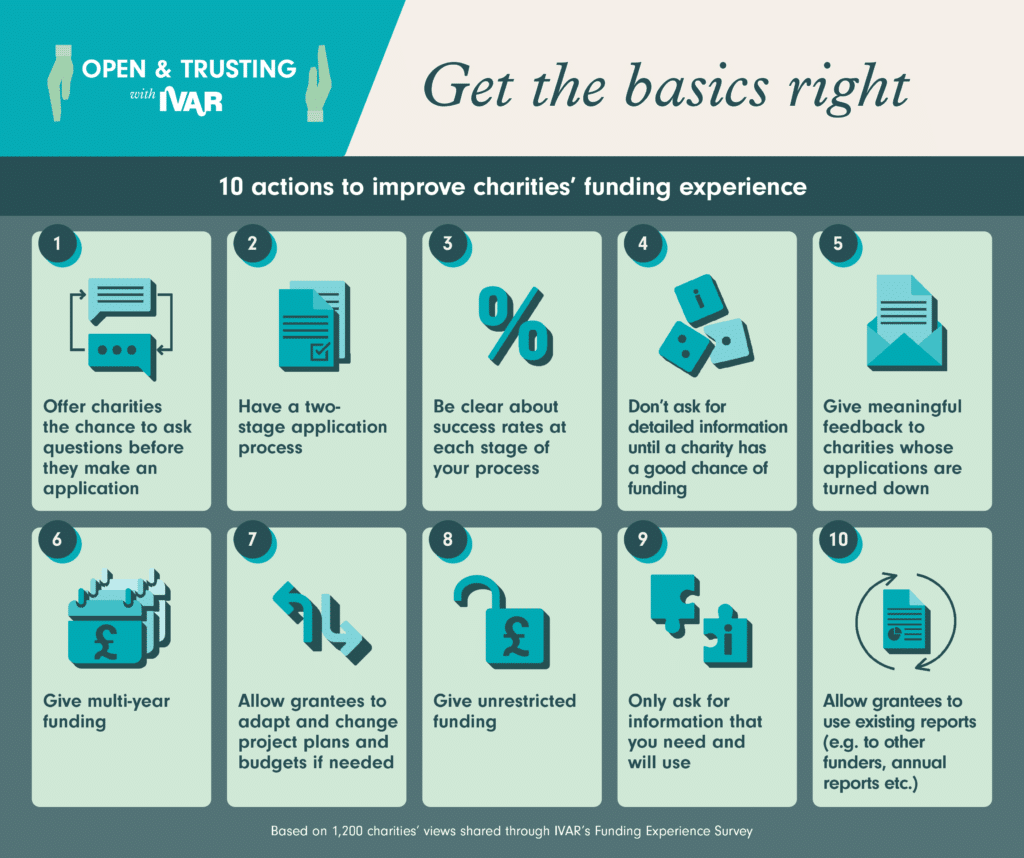
3 messages for 2023 from our popular content of 2022
January is often reserved for taking stock, reflecting on the year passed and identifying learning to take forward. At IVAR, it’s no different. We’re not only looking at how we’ve worked, but also exploring themes from across different projects and perspectives. And in true IVAR fashion, we’re running a series of exercises and conversations across the organisation to deeply reflect on this and inform our future direction. One question we often have is around how people engage with what we share: what do people find most useful and usable? In assessing the analytics of our website for 2022, I’ve seen some interesting trends that feel key to spotlight, as we head into the new year. This blog shares some of the top IVAR pages and key messages to take away.
Unrestricted funding
Who is this for?
For trusts and foundations.
This page also includes useful tips for charities applying for unrestricted grants.
What project is this from?
We launched the unrestricted funding page at the end of 2021 – it’s popularity has grown throughout 2022. The insights on this page pull from the research we conducted with 12 trusts and foundations on their thinking and approach to unrestricted funding. Our learning is synthesised into the report The holy grail of funding: Why and how foundations give unrestricted funding. We initiated this research as part of our Open and Trusting Grant-making initiative.
What have we learned?
Our work has identified several reasons why there’s value for foundations to offer unrestricted funding, from supporting charities to deliver effective work to building their resilience. However, the conversation of unrestricted can often circle around barriers to implementing. Our research has identified a series of critical questions to guide foundations through this, covering: legal powers and purpose, effectiveness, equity, risk and who bears it, and judging impact and success.
For charities, we share ideas that can support you in making your case on applications for unrestricted funding.
What message can you take forward?
Unrestricted funding can be a key way to lessen the inherent power dynamic in the funder-grantee relationship. At its core, it’s a demonstration of trust on behalf of the funder and a recognition that charities are the experts in what they do, as those embedded in their communities and delivering the work. Our research continues to highlight the value of unrestricted funding for both charities and funders.
Yet, we recognise that offering unrestricted funding may take bigger shifts for some funders than others, and that’s why we hold spaces for foundations to explore their challenges and share research that can stir thinking around this. Some funders are further along the journey than others, but any small shift towards more flexible funding is a step in the right direction. One simple question that can drive progress is always asking ‘can we go further?’
In addition to the summary webpage, many people are still downloading the report a year since its launch. And readers continue to (re)discover Nick Addington’s blog on two practical ways they’re approaching unrestricted funding at the William Grant Foundation. To me, this indicates a keenness to learn from the path taken by those further along. Transparent accounts will therefore support other foundations to develop their approach. Collectively, this will make the lives of charities easier.
Thinking about… Charity Reserves
Who is this for?
For trusts and foundations, charities and boards, regulators and policymakers.
What project is this from?
The Scotland Funders’ Forum commissioned IVAR to develop a deeper understanding of the role that charity reserves can play: from making them work harder to how they contribute to a dynamic and resilient voluntary sector. While the focus is on Scotland’s voluntary sector, the work provides practical advice that can be applied UK-wide.
What have we learned?
Through a literature review and rich conversations with both foundations and charities, we investigate how charity reserves are perceived and managed. We saw creative use of reserves, with positive examples that shine a light into how they can be used more purposefully. But there were also barriers that charities face in sustaining and growing due to how they work and who funds them.
Key findings highlight the charitable mission as a driving force for reserve use, which allowed charities to weather adverse conditions or be innovative. While practices across charities can vary, much can be achieved through strategic management. Best practices are underpinned by considering multiple key factors that impact the reserves, reflecting on their unique circumstances, having a focus on the future, and effective communications of the policy.
What message can you take forward?
For charities wanting to strengthen their reserves management, they can equip themselves through training; and by integrating reserves into budgeting, planning and risk management.
There is also a role for funders, regulators and trustees to support the strategic use of reserves through funding and/or practical guidance, as applicable to the support they provide the charity. The Scotland Funders’ Forum will be thinking about the next steps, but encourage all to think about the part we play in building more purposeful reserves.
Getting the basics right: The funding experience
Who is this for?
For funders.
We invite charities to continue to participate in our work to translate their experiences into funder actions. Please sign up to our charity bulletin to receive updates here.
What project is this from?
The Funding Experience Survey is part of our Open and Trusting Grant-making initiative and one step in an accountability process for the trusts and foundations signed up. Funders undertook a peer review session led by charity reviewers to assess their current practice and commitments alongside the survey findings.
What have we learned?
1,200 charities told us why how funding is distributed and managed matters, identifying actions and behaviours that feel open and trusting. This short 20-minute survey allowed us to capture a national snapshot of what charities feel will make a real difference, right now. The resounding message was to get the basics right, with a recommendation for 10 funder actions.

Charities can have great influence by speaking collectively on issues in their funding experience. We see IVAR’s role, at the interface between charities and funders, to hold space for charities to share their views and translating this into key messages on funder practice that will make a real difference. We continue to think about this as we flesh out our offer to charities and funders going forward.
What messages can you take forward?
These 10 funder actions may not sound revolutionary but they will certainly feel it to charities if implemented effectively. We asked (and continue to ask) funders to look at these actions with fresh eyes: to review and adapt how they do things, and encourage and support other funders in their development – which will show that funders are listening.
A thread that runs through these pieces is setting charities up well for the future. This is not a new theme from our work by any means, but the message feels even more pressing as we navigate the Cost of Living crisis. We hope you are able to reflect on what these findings mean for your organisation and how you work. We also ask that you support us in sharing this piece, so that the insights shared are adopted more widely. Please do connect with us as we continue to explore these themes and more in 2023. As ever, we look forward to listening and learning with you.

